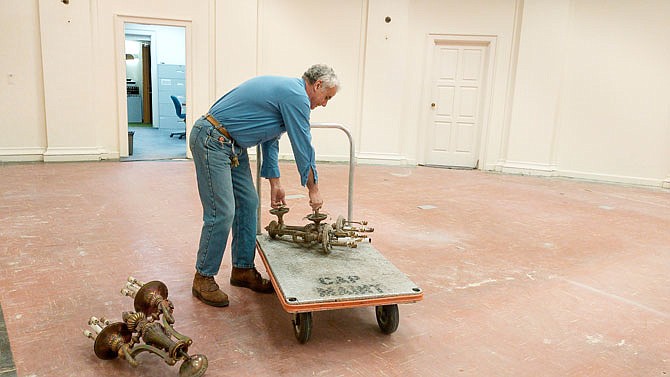Within the next month - and certainly before the end of the legislative session - the Missouri Capitol will have another hearing room.
Last month, the Legislature's Joint Committee on Legislative Research approved converting about 2,000 square feet of the former Legislative Research office on the Capitol's first floor into a hearing room - at least for the rest of this session.
"It was agreed upon that we are lacking in general hearing room space," House Chief Clerk Dana Rademan Miller told the News Tribune last week, "and this is a good way to utilize space that's been empty - or close to empty - for quite a while."
The space, which is directly under the governor's second-floor office, originally was the Capitol's cafeteria - and Miller said officials considered restoring it to that purpose.
"After looking at the building and looking at the way the building is designed - and having an architect come in who was very thoughtful about this in his work with other state capitols," she explained, "it was agreed that the best use of that space would be a shared space for a hearing room and, perhaps, what we call a community room."
Miller also chairs the Missouri Capitol Commission, which is considering a long-range master plan for the century-old building.
"It is recommended that that space would be a permanent joint hearing room in the future if any major restoration were to occur in the building," she said. "That would be the goal, that that space be converted into a permanent hearing room.
"We (would) have a schedule worked out with the clerk of the House and the administrator of the Senate to have a schedule where, if we know a hearing is coming up that's going to bring a lot of the public in, and we need a large space," a committee from either the House or Senate could meet there.
But, when not being used for legislative hearings, the space could be a gathering place for visitors, Miller said.
"In other states, they've got lunch rooms where people can come in and bring lunches or have meetings and such - and maybe that's something we look at in that master plan," Miller said. "We have so many school groups that come in, and there's always a need for somewhere on a rainy day for school kids to eat their lunch. Right now, they sit on the steps of the Grand Staircase."
But, the clerk said, the immediate need is for more meeting space.
"We could set the space as it is now with up to 40 members of a committee," she explained, "and (public) seating for 99."
That would make the new space the largest hearing room in the Capitol - slightly larger than House Hearing Room 3, which has 96 chairs for the public seating, as well as space for the 35-member House Budget Committee and its staff.
But that room also has a big support pillar in the middle, while the first-floor space would be open.
"(Another) problem is - especially in the Senate right now," Miller said, "their hearing rooms often reach maximum capacity, and members of the public have to take turns coming and going because it's standing room only. So this would be a way also to relieve some pressure from some of the committees that we have."
The House once had a large legislative research staff, whose duties included helping to draft bills and amendments, as well as memorials and resolutions, during the legislative session.
But that work was cut back in 2015 in favor of the House having its own bill-writing staff - as then-Clerk Adam Crumbliss told the News Tribune: "For a long time, you had the Senate doing their own drafting, but the House (used) Legislative Research. Some of the challenges that we had to deal with periodically were frustrations with getting things in a timely fashion - not really knowing exactly when or how we might get records and documents back."
The Legislative Research and Revisor of Statutes offices now employ only a handful of people in offices that generally line the north outer wall of the Capitol - and the large area the office once occupied generally has been empty.
Miller said last week officials were finalizing orders for the project - like chairs for the lawmakers and public, and carpet squares to cover the tile floor.
She expects the room to be ready for the Conference Committee hearings on the budget in late April or early May, if not before.
Miller said the project will cost a little over $49,000 - and equipment and furniture purchased now will be re-usable in other hearing rooms.

